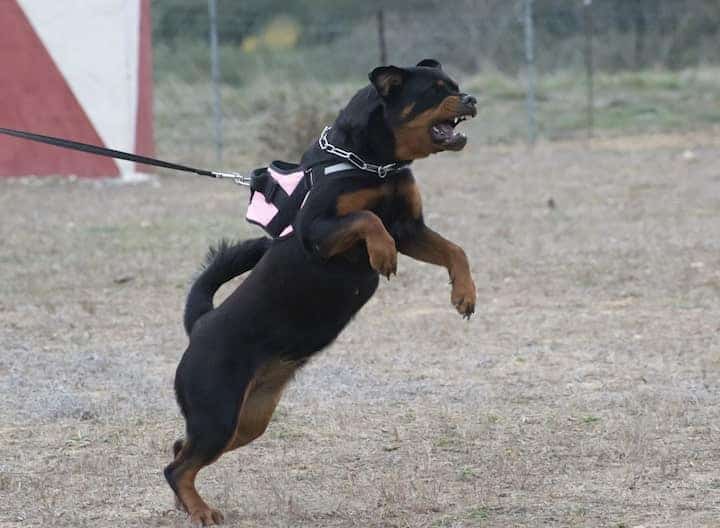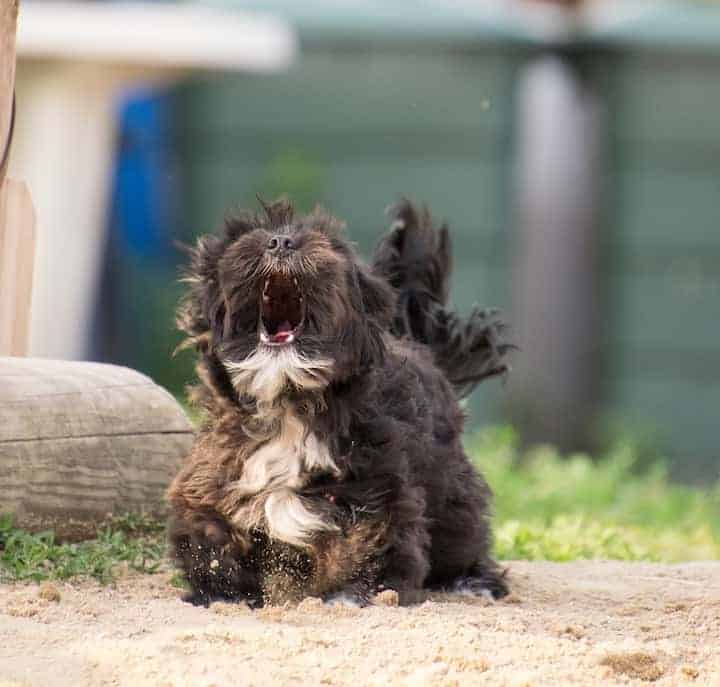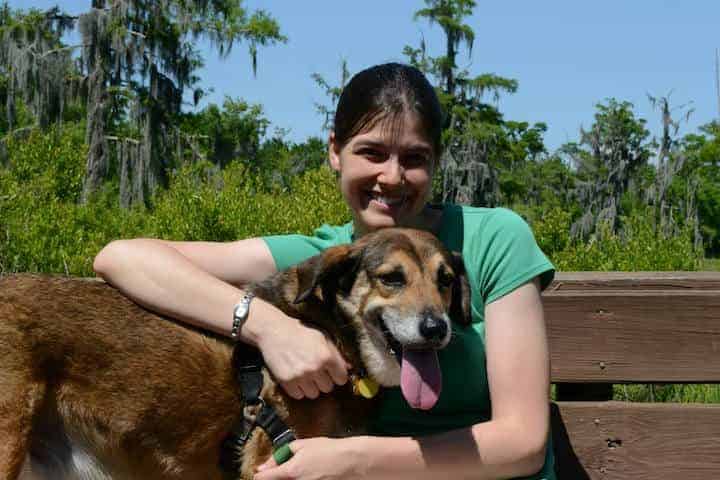
Leash reactivity is one of the most common canine behavior issues. It is so prevalent that there are whole books dedicated to the subject and entire obedience classes that revolve around that one issue.
If you are struggling with a dog who barks, lunges and pulls on the leash when he sees other dogs, you are not alone!
Leash reactivity can be incredibly frustrating and embarrassing. It is disheartening when you just want to take your pet on a pleasant afternoon stroll, but you feel that you cannot trust your pet to behave in public.
The great news is that with training, consistency and patience, you can see huge improvements in this behavior.
However, certain types of trainers and training methods can make this problem worse. Therefore, you must be careful about how you try to fix this behavior issue.
In this article, we will help you understand leash reactivity and give you tips to work with a leash reactive dog. We will also explore how certain types of training can exacerbate the problem so that you can avoid inadvertently making the problem worse.
Most importantly, we will help you form a strong working relationship with your leash reactive dog.
What is Leash Reactivity?
Leash reactivity is also sometimes known as leash aggression.
Dogs who are leash reactive will pull, bark and lunge at other dogs when they are on leash. They might even try to bite another dog.
Just because a dog is leash reactive does not necessarily mean that the same dog is dog aggressive.

Lots of dogs act aggressively on leash but are friendly towards other dogs when interacting off leash.
Why?
The leash hinders a dog’s ability to communicate and interact with other dogs in a natural way.
When dogs are on leash, they feel frustrated, confined, and at a disadvantage. They are more likely to “act out” and try to “appear tough” when they feel uncomfortable.
In short, they are nervous, scared, unsure, anxious and upset.
Note—there are also some dogs that “go crazy” on walks simply because they are overly-excited by the presence of another dog and desperately want to play with that dog.
They are not aggressive at all; they are just out of control. That is a slightly different situation, but these tips will work for them, too!
How to Work with Leash Reactivity
Working with a leash reactive dog is a bit counterintuitive.
Our first reaction is to scold or punish the dog when he is doing something that we want him to stop.
However, in this situation, punishment does not work. More on this later.
Remember that your dog is acting this way because he is nervous and upset.
We need to change his internal reaction when he sees another dog—we need to change his emotional response.
We must shift his thought process from, “uh oh, there’s another dog, I don’t know what to do, I’m upset, mom’s upset, I am going to bark at the dog and make it go away.”
We need to change it to, “hey, there’s another dog, good stuff is about to happen! Weee!”
Here is how we facilitate that emotional shift.
A Training Plan for Leash Reactivity
If your dog has severe leash reactivity or true dog aggression, we recommend working with a professional positive reinforcement trainer while you go through these steps.
Step 1. Increase exercise and mental stimulation
Your dog will be able to focus better on training if you expel some of his excess energy.
Since it can be hard to exercise leash reactive dogs by walking them on leash, you will have to get a bit creative.
If your dog is friendly with other dogs off-leash, sign him up for doggie daycare a few times per week.
This is an awesome way to expel some energy and, in some cases, more socialization with other dogs will help his reactive behavior.
If your dog is not friendly with other dogs, focus on increasing your dog’s mental exercise at home.
Mental exercise is just as tiring to dogs as physical exercise!
Try adding at least one 30-minute training session every day. Practice basic commands like sit, down, stay, come, leave it, go to your mat, touch (hand target), shake, watch me, etc.
Reward Eye Contact
Before you venture out into the world, practice some training exercises that encourage eye contact, focus, and attention on the handler. Here is a great game for encouraging eye contact:
Made You Look
Hold some treats in your closed fist with your arm outstretched to the side.
Your dog will probably stare at your closed fist. Be patient and watch your dog like a hawk.
The moment your dog flicks his eyes towards your face for a second, say “yes” and give him a treat from your hand.
Repeat and practice in different environments. This training game will reinforce your dog for choosing to look at you. This will come in handy later.
Step 2. Dog= Chicken
Now it is time to start doing some training around other dogs. If possible, recruit a friend with a calm, neutral dog to help you with the first steps of the process.
Use a delicious treat that your dog never gets under any other circumstances.
We recommend small pieces of roast beef or rotisserie chicken (with skin removed).
Start with your helper and helper dog at an extremely far distance. You want to set your dog up to be successful during the first session.
Walk your dog around the practice area and anytime the other dog comes into his field of vision, praise him in a happy voice and start feeding him tiny bits of chicken.
As soon as you move into an area where the dog is no longer in sight, stop giving rewards.
Your dog is learning that the presence of another dog means great things will come from his handler!
Over time, you should be able to get closer and closer to the other dog in your practice sessions.
In time, your dog will automatically look at you when he sees another dog in the distance because he knows that he is about to get an awesome payoff!
Step 3. In the Real World
Carry a treat pouch with your dog’s special training treat when you go on walks.
Try to be alert and keep as much space between you and other dog walkers as possible.
As soon as you see another dog in the neighborhood, start praising and feeding chicken.
Alter your direction if you are going to pass too close to the other dog.
Try to always keep your dog below his threshold (i.e. the point where he will react towards another dog).
Keep feeding and praising while the other dog is in sight. Stop when the dog disappears.
Praise and feed even if your dog barks or lunges at the other dog. Remember, you are not rewarding the behavior, you are changing your dog’s emotional response to the presence of another dog.
You want your dog to think: other dogs = good things!
Training Plan Summary
This training plan really works but it takes time, commitment, and patience.
Your dog’s behavior will not change overnight, but you should start seeing some improvements within a few weeks.
There will be awesome days and there will be days where you have setbacks. That is ok!
Stick with it and after a year, it will be like you are walking a completely different dog!
This training plan will help you expand the world for your dog so that you can take him on fun adventures, and it will accomplish that goal without fear or pain.
When you use positive training to work with your dog through a challenging behavior like leash reactivity, it creates an unbelievable bond between the dog and the handler.
If you follow this guide and use positive training tactics, your relationship with your dog will be stronger than ever.
What Not to Do
Now let’s take a moment to explain why punishing leash reactivity does not work, even though it might seem like the obvious way to stop “bad behavior.”
There are even professional trainers who will suggest things like, “you have to show him that you are the leader and that you will not tolerate that behavior,” or, “you have teach him that he made the wrong choice in that scenario.” Do not follow this advice. Keep looking and find a different trainer.

It is understandable why you might think punishment would work. The dog displayed a bad behavior and if we issue a correction for that bad behavior, he will not do it again.
However, this is how your dog interprets the punishment:
“I see a dog coming towards us. I am worried, I do not know what to do. I will act tough. I will make it go away.”
Then your dog gets corrected by a painful pop of the prong collar, an electric shock or yelling.
Now your dog thinks, “Oh gosh, other dogs are horrible. They make my mom so upset; they make painful things happen to me. I am going to be even more defensive next time and I will be on high alert at all times.”
It is true that the shock and pain of a punishment can work in the short term, but it will not change your dog’s underlying fear of the situation. In fact, it will compound that fear.
Over time, your dog’s aggression will get more and more severe and become harder and harder to keep under control.
Ben’s Story- A Case Study
This point is illustrated by the story of a dog named Ben who was owned by a professional dog trainer named Emma Parsons.
Ben was a Golden Retriever who was purchased from a breeder to be trained as a competitive obedience dog.
When he reached his teenage phase, he started to bark and growl at other dogs unprovoked.
Emma was shocked by this surprising behavior. Over the next few months the behavior got worse and Emma made an appointment with a professional trainer who was an expert in dog aggression.
During their lesson, the trainer punished Ben severely anytime he showed aggression toward another dog.
He even lifted Ben off his feet using a prong collar and hung him in the air until he showed signs of submission.
Emma was horrified, but this was an expert who presumably knew what he was doing.
The next time Emma brought Ben to his regular obedience class; Ben launched into a rage as soon as he saw another dog in the parking lot. He screamed, salivated, lunged, bared his teeth and could not calm down. His behavior was much worse.
With a positive training plan, Ben’s reactivity probably could have been extinguished.
However, the corrective, dominance-based trainer made Ben’s reactivity so much worse that Emma spent years trying to undo the damage and slowly build up Ben’s confidence in the world.
Emma worked with a positive reinforcement trainer, Karen Pryor, to successfully rehabilitate Ben.
After working with her own dog, Emma Parsons became a leader in the field of rehabilitating aggressive dogs.
Her book, Click to Calm: Healing the Aggressive Dog is a fabulous resource for any owner struggling with leash reactivity or other aggression issues.
Need More Help? Find a Trainer!
Hopefully, this training article has given you some inspiration and some helpful hints to work with your leash reactive dog.
However, if you need more help, do not hesitate to reach out to a professional positive reinforcement trainer.
You might also want to look into signing up for a Reactive Rover class in your area. These classes are very popular and quite fun!
A class environment is a great way for your dog to practice around other dogs in a highly controlled environment.
Plus, you will get to swap stories with the other pet parents and be part of a supportive community.
Ask your veterinarian or local humane society for recommendations of positive reinforcement trainers in your area. Be sure to ask about their training methods and request references before signing up.
The Academy for Dog Trainers also has a website for finding positive reinforcement trainers in your area.

Allie has worked in the field of animal welfare for over ten years and as a freelance writer the space for many years. She has had many different kinds of dogs (and cats) throughout her life—all adopted. She currently shares her home with a lovable pit bull mix named Huckleberry.